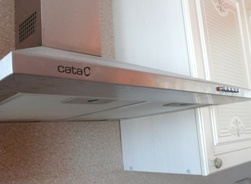Categories: Sharing experience, Electrical connection of equipment
Number of views: 50160
Comments on the article: 6
How to connect a cooker hood to an electrical network
 A cooker hood is an integral element of a kitchen interior. A range hood provides a comfortable stay for people in the room, clearing the air of unwanted odors and burning. If you need to connect a cooker hood, a lot of questions arise, one of which is how to connect a cooker hood to an electrical network.
A cooker hood is an integral element of a kitchen interior. A range hood provides a comfortable stay for people in the room, clearing the air of unwanted odors and burning. If you need to connect a cooker hood, a lot of questions arise, one of which is how to connect a cooker hood to an electrical network.
The connection of the hood is carried out, as a rule, in a conventional power outlet. Therefore, it is recommended to provide a socket for connecting the hood when performing electrical wiring replacement work. Consider the features of installing a socket for a kitchen hood.
The power consumption of the cooker hood is relatively small, so it is not practical to pull a separate wiring line from the distribution panel. The outlet in this case can be connected in a junction box. If during installation electrical wiring in the kitchen it is not planned to install an intermediate junction box, the outlet for exhaust can be connected by a cable from another outlet.
Which cable (wire) to choose to connect the hood outlet? Power consumption of a kitchen hood 100-400 W, load current, respectively, no more than two amperes. In this case, you can choose a cable with a cross section of 1-1.5 square meters. mm, which will provide a margin for the load and in the future, if necessary, it will be possible to include another household electrical appliance in this outlet.
If you connect the outlet to one of the kitchen outlets (with a loop), then you can not purchase a cable (wire) separately, but use the rest of the cable used to lay the wiring lines for other outlets.
In the event that the load on the outlet to which the outlet for the hood is planned to be connected is large, it is not recommended to make intermediate contact connections (for branching the wiring line supplying the hood).
In this case, you can initially lay the cable in such a way that it is enough to connect in both outlets, that is, lay the cable to one outlet, strip it without cutting, connect to this outlet and conduct to the outlet that supplies the cooker hood.
In the event that the wiring is already mounted, and you need install outlet for hoods, the most acceptable way is to connect the outlet with a cable. If the kitchen is repaired and furniture is installed, ditch the wall will not work. In this case, the best option is to purchase plastic cable channel.
The modern assortment of cable channels allows you to choose the most optimal option for your interior. For example, you can choose a plastic cable channel “wood-like”, which will fit into the interior design, and will not stand out from the kitchen furniture.
A branch of the wiring line of one of the sockets for connecting a cooker hood can be done using terminal blocks or any other way of connecting the conductors (soldering, welding, crimping), depending on the availability of free space in the installation box, where the branching line is wired.
You can also purchase a power outlet with two pairs of contacts and connect a power supply line and a line that needs to be connected to supply the kitchen hood to this outlet.
Look on the topic: Connection of an electric stove and a washing machine in the TN-C system

See also at bgv.electricianexp.com
:
